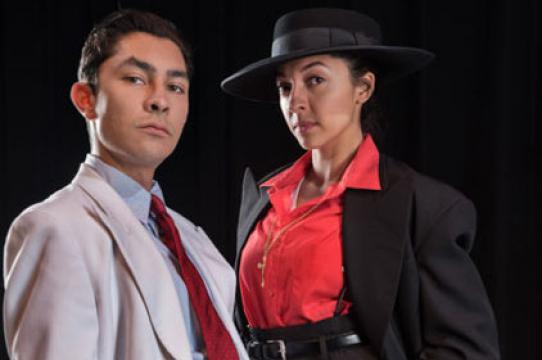After the bombing of Pearl Harbor in 1941, the U.S. Office of Price Administration rationed commodities needed in the war effort.
These included gasoline, metal, electricity, sugar, meat, butter, nylon, silk, batteries, and fabric. Before the war, a standard men’s suit came with a vest and two pairs of pants. The wartime “Victory Suit,” however, was single-breasted, with narrow lapels, no cuffs, no pocket flaps, no vest, and only one pair of pants. The Zoot Suit, on the contrary, consisted of a knee-length jacket with very wide lapels, padded shoulders, worn with high-waisted, full-cut baggy trousers that tapered to narrow cuffs, held up with wide suspenders, an elaborate vest, and a long wallet chain, with wide-collared shirts and a very wide-brimmed hat. A status symbol among ethnic minorities, the Zoot Suit was seen by whites as an act of defiance during wartime, and Zoot Suits could only be acquired through bootleg tailors. The fashion, then, became not only a symbol of racialized hooliganism, but an insult to the soldiers and sailors prosecuting the war overseas. Associated as it was with minorities, the zoot suit became a target for growing expressions of racism and white nativism.
The Zoot Suit and the Pachuco
“What distinguishes them, I think, is their furtive, restless air: they act like persons who are wearing disguises, who are afraid of a stranger’s look because it could strip them and leave them stark naked... . They are instinctive rebels, and North American racism has vented its wrath on them more than once. But the pachucos do not attempt to vindicate their race or the nationality of their forebears. Their attitude reveals an obstinate, almost fanatical will-to-be, but this will affirms nothing specific except their determination... not to be like those around them.”
—Octavio Paz, The Labyrinth of Solitude
Pachuco was originally a derisive term that Mexicans and Mexican-Americans employed to refer to the poorer denizens of El Paso, Texas (Chuco Town). Like other Chicanos, Pachucos labored on railroads and in migrant farms and found their way all over America, but a large population settled in Los Angeles in the 1920’s and 30’s. Their children adopted the zoot suit along with a unique slang, called Caló, which is a mix of Anglicized Spanish, Hispanicized English, gypsy zincaló, Aztec Nahuatl, and a splendid plethora of neologisms and rhymes.
By the 1940’s, wearing the Zoot Suit made young L.A. Pachucos particularly vulnerable to guilt by association as wartime hysteria went so far as to accuse Zoot Suiters of willing collaboration with Nazis or even of acting as fth columnists under the orders of Japanese who were interned in California camps.
Michael Chemers is Associate Professor of Dramatic Literature. Nina McMurtrie is a student in the Masters of Arts Program in Theater Arts. Victoria Gardiner is a Theater Arts Major.
